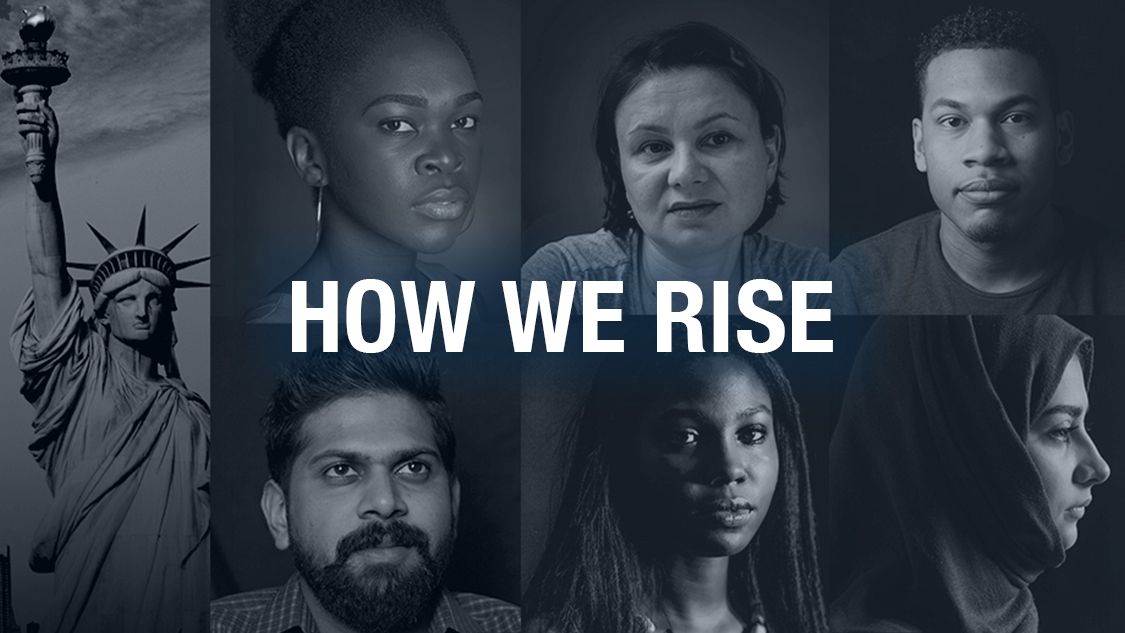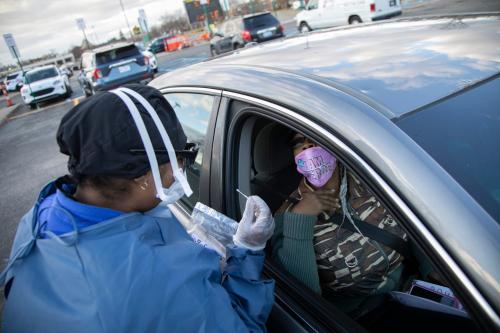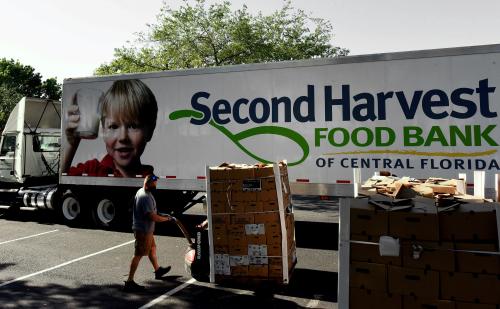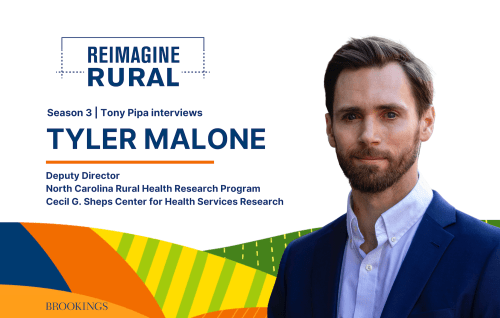The Covid-19 pandemic has had a disproportionately devastating impact on Black and Latino communities—both from an economic and a health perspective. Last year, Black and Latino individuals experienced 2.9 and 3-year declines in life expectancy respectively, largely due to Covid-19 deaths. That is roughly 2.5 times the decline for white individuals.
As the Omicron variant continues to spread and we wait for this most recent wave to break, it is crucial that we not only recognize the racial differences in Covid-19 cases and deaths thus far but also begin to understand the underlying mechanisms that give rise to these disparities. In a recent report written with Andre Perry and Carl Romer, we explore the causes of Covid-19 racial disparities using a social determinants of health framework. The U.S. Department of Health and Human Services (HHS) defines the social determinants of health as “the conditions in the environments where people are born, live, learn, work, play, worship, and age that affect a wide range of health, functioning, and quality-of-life outcomes and risks.” These social determinants are downstream of policy decisions that give shape to these conditions—decisions known as structural or political determinants.
As David Dawes, from the Morehouse School of Medicine, explains in his recent book on the subject, “political determinants of health involve the systematic process of structuring relationships, distributing resources, and administrating power.” In our report, we discuss several key social determinants that are contributing to racial disparities in cases and deaths. Here, we focus on three—health care access and insurance, environmental exposure, and food access and nutrition. We briefly summarize the evidence for each determinant’s contribution to health disparities and propose policy solutions that could help reduce racial inequities by addressing underlying structural issues.
health care access and insurance
Latinos are three times more likely to not have health insurance than white Americans. For Black individuals, that number is 1.7. As we’ve noted previously, health and health care have a bidirectional relationship. “Poor health care leads to poor health, which then makes health care more expensive and less accessible.” This is especially true in the context of the pandemic. A recent study finds a strong negative correlation between a county’s insured rate and its number of Covid-19 cases and deaths. Furthermore, for individuals who get severe cases of Covid-19 and need medical attention, those without insurance often pay more money out of pocket for treatment due to how the CARES Act’s reimbursement program is structured.
The racial gaps in health insurance rates may also be contributing to disparities in Covid-19 outcomes through their effect on vaccine access. While much has been written about the ways in which Republican messaging is contributing to vaccine hesitancy, an often overlooked determinant of vaccination status is health insurance coverage. Among 25 different socioeconomic groups including gender, race, income level, and political affiliation, the group with the lowest vaccination rate is uninsured individuals under 65.
To reduce racial disparities in Covid-19 outcomes and future health outcomes, we need to improve health care access for Black and Latino communities. Some policies to improve access include:
- Expand Medicaid and create federal fallback that guarantees coverage for people in the “coverage gap” meaning those who are below the federal poverty line but are not eligible for Medicaid. This is particularly important because individuals in the coverage gap are disproportionately Black and Latino.
- Remove immigration-related requirements for Medicaid eligibility.
- Implement temporary paid sick leave specific to Covid-19 either at the federal or state
Environmental exposure and air pollution
The U.S. Environmental Protection Agency (EPA) emphasizes fair treatment in its definition of environmental justice. “No group of people should bear a disproportionate share of the negative environmental consequences resulting from industrial, governmental and commercial operations or policies.” Unfortunately, we routinely fail to achieve this aspiration, often due to the lingering effects of entrenched racism. For example, a recent study of 108 U.S. urban areas finds that places that were formerly discriminated against via redlining and other housing policies are now disproportionately exposed to heat waves due to a lack of greenspace.
In the context of Covid-19, a respiratory virus, air pollution is the form of environmental exposure most relevant for explaining some of the disparities in death rates. Indeed, a preprint study from medRxiv finds strong correlations between levels of air pollution and Covid-19 death rates. Here too, environmental injustice produces disparate outcomes across races. For instance, prior research from the American Medical Association documents growing differences in air quality and respiratory health across neighborhoods with different socioeconomic compositions. The data suggests that while air quality varies across income levels, it varies more widely by race. We find that there is a greater correlation between the presence of respiratory hazards in a neighborhood and the size of Black/Hispanic populations than the correlation between those hazards and income and poverty. And recent research has found that communities of color are disproportionately harmed by air pollution even though their consumption contributes significantly less to emissions than both the national average and the average for white communities.
The decisions about where to locate trash incinerators, factories, interstate highways, or other potential hazards are policy decisions whose structural impact gives rise to disparate social conditions. There are at least two ways we can begin to address these injustices through better policy choices. We should:
- Address market failures through targeted regulations. Recent Brookings analysis documents how the Trump administration implemented “significant rollbacks of major rules affecting air quality” which included “weakened mercury and air toxics standards for coal plants, reduced stringency for new car fuel economy standards, and denied petitions from states requesting regulatory assistance for air pollution that crosses state lines.” The Biden administration recently announced that it is restating some of these rules surrounding air pollution. The administration should continue to reinstate prior rules stripped away by the previous administration, while also identifying other weaknesses in the current regulatory environment.
- Invest in green infrastructure. According to the EPA, green infrastructure—including trees, shrubs, and other vegetation—can help improve air quality and reduce urban heat island effects while also helping communities manage stormwater runoff. And a comprehensive literature review finds that green infrastructure can also reduce disparities and address issues including obesity, cardiovascular health, heat-related illness, and psychological health.
Food access and nutrition
Food access and nutritional intake are closely tied to a number of diseases like hypertension, obesity, and diabetes, all of which disproportionately affect Black and Latino or Hispanic individuals in the United States. These diseases have been identified as leading comorbidities of Covid-19, meaning those who have them tend to have worsened Covid-19 outcomes. Many experts cite nutrition as a factor but focus on individual decisionmaking about diet. But a structural account needs to account for the various constraints that households face when making decisions about food. Reducing obesity and diabetes rates is a complex problem that requires long-term solutions but improving access to healthy food and reducing food insecurity among low-income households is a good first step.
Over one in ten families face food insecurity in the United States—and that was before the start of the pandemic, which made things worse. These families are disproportionately Black, Latino, and living below the poverty line. The federal government’s Supplemental Nutritional Assistance Program (SNAP), whose recipients are also disproportionately Black and Latino, is meant to address this economic issue. In theory, SNAP is designed to help families near or below the federal poverty line afford a healthy diet. But in practice, SNAP is often insufficient for low-income families to sustain healthy diets because the benefits were based on an outdated model of food consumption and pricing. Thankfully, the model has recently been updated, resulting in a large increase in regular SNAP benefits that began in October 2021.
One policy that has been shown to reduce food insecurity drastically is the expanded child tax credit (CTC). The expanded CTC, which was implemented in March 2021, led to a 25% decline in food insufficiency among low-income families with children. Nevertheless, the expanded CTC received only temporary authorization and has since reverted to its original form, thereby eliminating the monthly payout and lowering the overall amount of support provided to families. Reestablishing the enhanced monthly CTC is of the utmost importance to ensure that we continue to make gains in food security and overall health without losing the progress we’ve already made in the last year.
COnclusion
The United States has lost over 900,000 lives to the Covid-19 virus, and according to analysis by Reuters, the nation ranks worst in per capita deaths among the group of the seven wealthiest countries (G7) in the world. It is clear that we need permanent policy solutions to address the underlying causes of racial disparities in health outcomes. To respond adequately to these disparate outcomes now during the ongoing pandemic, and to prepare for the next health crisis that will inevitably come along, we must improve the built environment, broaden and deepen the social safety net, and ensure that everyone has access to the health resources they need in order to flourish.
The Brookings Institution is committed to quality, independence, and impact.
We are supported by a diverse array of funders. In line with our values and policies, each Brookings publication represents the sole views of its author(s).










Commentary
The pandemic showed why social and structural determinants of health matter. Now it’s time for policymakers to act.
February 18, 2022